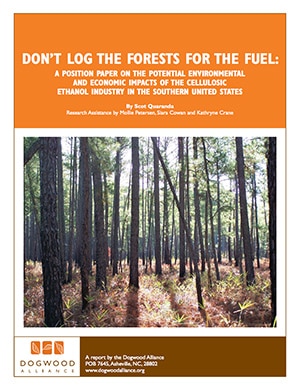Dont Log the Forests for the Fuel
Dogwood Alliance
We live in a rapidly changing world in which the cumulative impacts of 200 years of industrialization and population growth are catching up with us in the form of global climate change. Add to this our ever growing need for energy to support our Western lifestyle and the continuously growing global population and we are setting ourselves up for an ecological nightmare unless dramatic changes are made in the short-term.
As oil prices climb and global demand threatens to overwhelm supply, we flail in the dark for alternatives to fossil fuels that will allow us to sustain current and growing levels of energy demand and keep the global economy humming. The list of solutions grows daily, with inventors and investors hoping to find the silver bullet. Some solutions seem hopeful and others do not. Add to that growing list a second generation biofuel, called cellulosic ethanol, which when looked at under close scrutiny is at minimum a false solution and, in the worst case scenario, a disaster for our forests that will exacerbate global climate change rather than combat it. Cellulosic ethanol is made by breaking down woody fiber and converting the byproduct into fuel.
We certainly are not suggesting that our current reliance on fossil fuels is a viable alternative. However, based on the inefficiency of the current production technology and its reliance on fossil fuels in production combined with the environmental and community impacts that will be outlined below make cellulosic ethanol a false solution. It should be set aside in favor of more positive solutions. Biofuel has served as a distraction and diverted funding which could have been utilized for more proven or promising technologies in the area of conservation and efficiency, solar, wind and hydrogen technology, and more.
The forests of the Southern U.S. are a global treasure. These forests house amazing levels of animal and plant biodiversity, provide unique locales found nowhere else in the world, comprise a large percentage of total US wetlands and store millions of tons of CO2 as plant based carbon. From the Appalachians to the Ozarks and from the coastal swamplands to the majestic upland hardwood forests of the Cumberland Plateau these forests have the potential to support a sustainable combination of wood products companies, forest-based tourism, and cultural resources for local communities for generations to come.

